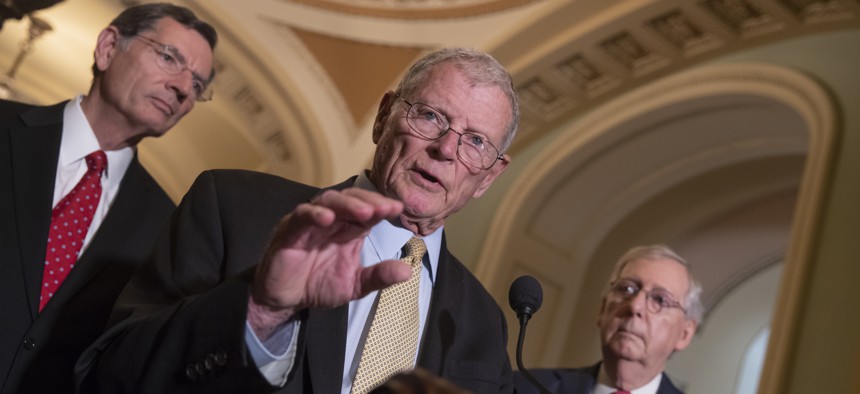
Sen. James Inhofe, R-Okla., a member of the Senate Armed Services Committee, center, joined by Sen. John Barrasso, R-Wyo., left, and Senate Majority Leader Mitch McConnell, R-Ky., talks about defense funding on Capitol Hill in Washington, June 12, 2018. AP Photo/J. Scott Applewhite
Opposition to a Space Force Simmers in the Senate
But Republicans who oppose the president’s push appear largely content to hold their fire until next year.
Senate Republicans are holding their fire for now on the creation of a sixth branch of the military to guard America’s interests in space, punting a fight with President Trump despite deep-seated skepticism about the wisdom of such a move.
The Pentagon is in the final stages of preparing a report to lawmakers laying out the groundwork for the change, including initial steps they can make without Congress.
But the final step—officially creating a new service branch—will require legislative authorization. And it is Senate Republicans who could stand in the way of Trump’s so-called Space Force; the House has already signaled its support for the move.
While key Republicans on the Senate Armed Services Committee said Wednesday that they continued to oppose the creation of a new branch, they noted that the proper vehicle for such a move is an annual piece of legislation that the Congress won’t take up again for a full year.
That may help Senate opponents avoid picking a fight with the president three months before voters go to the polls for the midterm elections.
“I’m opposed to [creating a sixth branch],” Sen. James Inhofe of Oklahoma, the number-two Republican on the Armed Services Committee, said Wednesday. “I know the president has strong feelings. I think we can do that without a new branch.”
But Inhofe stopped short of threatening to withhold funding or take some other legislative action to block the proposal.
“We’re through with it this year,” he said, referring to the 2019 defense authorization bill, which passed the full Congress on Wednesday. “But I’m sure we’ll be looking at it next year.”
Defense One this week reported details from the latest version of the proposal, drafted in large part by the number-two Trump appointee in the Pentagon: Deputy Defense Secretary Patrick Shanahan. According to the 14-page document, the Pentagon in the coming months will create a combatant command for space warfighting, establish a joint office to buy new satellites and develop new technology, and stand up a corps of space efforts from across the military.
Pentagon officials also plan to prepare a budget request to Congress for the 2020 defense authorization bill to create a new service branch for space activities.
But calls for a new service branch have faced fierce resistance within the Pentagon itself, including from Defense Secretary James Mattis. In a 2017 letter to Rep. Mike Turner, R-Ohio, who chairs the House Tactical Air and Land Forces Subcommittee, Mattis argued that the move would add an unnecessary bureaucratic and administrative burden.
"At a time when we are trying to integrate the Department's joint warfighting functions, I do not wish to add a separate service that would likely present a narrower and even parochial approach to space operations," Mattis wrote to Turner, who has vocally resisted the move on Capitol Hill.
The debate over the need for a separate branch of the military to handle space-related defense predates Trump by several administrations. Proponents of the move say that the U.S. risks being outpaced by China or Russia, who could pose a serious threat to American intelligence and communications satellites. Critics, meanwhile, fear adding another bureaucratic layer to an already sprawling organization would prove too costly—perhaps unnecessarily.
“I’d have to be convinced that it’s the right direction to go,” said Sen. Mike Rounds, R-South Dakota. “I don’t like the idea of creating another silo. Why not simply allow the Air Force to continue in the path they are with more emphasis on space activity?”
A bipartisan majority of the House signaled its support for the move last year, tucking a provision into the 2018 NDAA that would have created a new branch within the Air Force—similar to the way the Marine Corps is part of the Navy. That provision was stripped out during conference negotiations with the Senate.
In June, Trump appeared to fast-track the idea, surprising the Pentagon when he publicly ordered Chairman of the Joint Chiefs of Staff Gen. Joseph Dunford to shepherd the concept during a speech at a National Space Council meeting.
Close watchers of the debate see a determined push by the White House to fulfill the president’s demands, even over the reservations of some of his own senior defense leaders. At a Tuesday rally in Tampa, Florida, Trump reiterated his order for “the sixth branch of our military, the Space Force.”
“I think Shanahan and Mattis are being pushed by the White House to make this happen,” said Robert Walker, a former chairman of the House’s Science, Space and Technology Committee who now specializes in space issues at the Washington lobbying firm Walker and Wexler. “The president’s announced it and they want to make it happen and the question was whether you could do anything significant without bringing Congress into the process early on—and it appears to be that they’ve done a pretty good job.”
And on Wednesday, days after details from the draft proposal became public, Senate Republicans showed little appetite to kick up a fight. The upper chamber passed the 2019 NDAA on Wednesday afternoon before jetting out of town for a week-long recess; meantime, lawmakers won’t receive Trump’s budget request to stand up the new branch until early next year.
Between now and then, Republicans will face extremely contested midterm elections across the country, in many of which Trump is expected to be a critical factor.
In the meantime, the contours of the report appear to be in flux.
It was due to be delivered to Capitol Hill on Wednesday, but the Pentagon announced late Tuesday afternoon that it would be delayed. The reason for the delay was not immediately clear.
Press Secretary Sarah Huckabee Sanders on Wednesday told reporters that the White House was “continuing to work with the Department of Defense to figure out the best way forward, something the president feels strongly about.”
